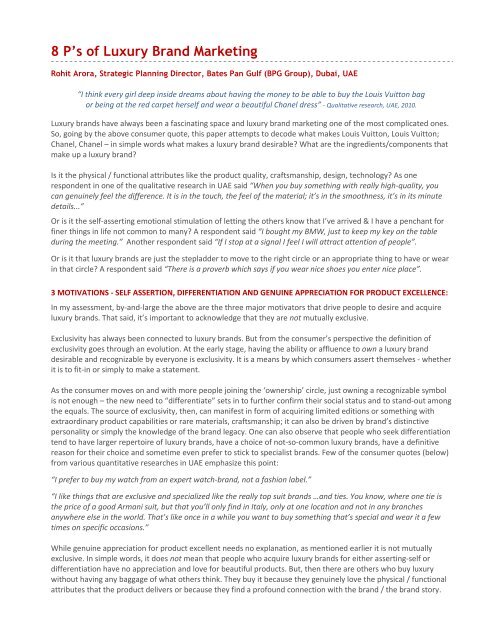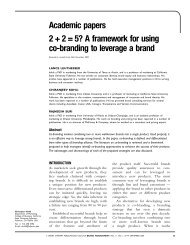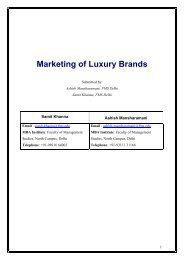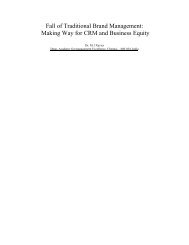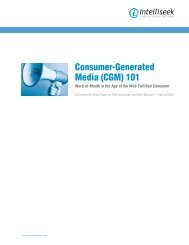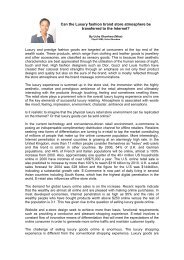8 P's Of Luxury Brand Marketing - Brandchannel
8 P's Of Luxury Brand Marketing - Brandchannel
8 P's Of Luxury Brand Marketing - Brandchannel
Create successful ePaper yourself
Turn your PDF publications into a flip-book with our unique Google optimized e-Paper software.
8 P’s of <strong>Luxury</strong> <strong>Brand</strong> <strong>Marketing</strong><br />
Rohit Arora, Strategic Planning Director, Bates Pan Gulf (BPG Group), Dubai, UAE<br />
“I think every girl deep inside dreams about having the money to be able to buy the Louis Vuitton bag<br />
or being at the red carpet herself and wear a beautiful Chanel dress” - Qualitative research, UAE, 2010.<br />
<strong>Luxury</strong> brands have always been a fascinating space and luxury brand marketing one of the most complicated ones.<br />
So, going by the above consumer quote, this paper attempts to decode what makes Louis Vuitton, Louis Vuitton;<br />
Chanel, Chanel – in simple words what makes a luxury brand desirable? What are the ingredients/components that<br />
make up a luxury brand?<br />
Is it the physical / functional attributes like the product quality, craftsmanship, design, technology? As one<br />
respondent in one of the qualitative research in UAE said “When you buy something with really high-quality, you<br />
can genuinely feel the difference. It is in the touch, the feel of the material; it’s in the smoothness, it’s in its minute<br />
details...”<br />
Or is it the self-asserting emotional stimulation of letting the others know that I’ve arrived & I have a penchant for<br />
finer things in life not common to many? A respondent said “I bought my BMW, just to keep my key on the table<br />
during the meeting.” Another respondent said “If I stop at a signal I feel I will attract attention of people”.<br />
Or is it that luxury brands are just the stepladder to move to the right circle or an appropriate thing to have or wear<br />
in that circle? A respondent said “There is a proverb which says if you wear nice shoes you enter nice place”.<br />
3 MOTIVATIONS - SELF ASSERTION, DIFFERENTIATION AND GENUINE APPRECIATION FOR PRODUCT EXCELLENCE:<br />
In my assessment, by-and-large the above are the three major motivators that drive people to desire and acquire<br />
luxury brands. That said, it’s important to acknowledge that they are not mutually exclusive.<br />
Exclusivity has always been connected to luxury brands. But from the consumer’s perspective the definition of<br />
exclusivity goes through an evolution. At the early stage, having the ability or affluence to own a luxury brand<br />
desirable and recognizable by everyone is exclusivity. It is a means by which consumers assert themselves - whether<br />
it is to fit-in or simply to make a statement.<br />
As the consumer moves on and with more people joining the ‘ownership’ circle, just owning a recognizable symbol<br />
is not enough – the new need to “differentiate” sets in to further confirm their social status and to stand-out among<br />
the equals. The source of exclusivity, then, can manifest in form of acquiring limited editions or something with<br />
extraordinary product capabilities or rare materials, craftsmanship; it can also be driven by brand’s distinctive<br />
personality or simply the knowledge of the brand legacy. One can also observe that people who seek differentiation<br />
tend to have larger repertoire of luxury brands, have a choice of not-so-common luxury brands, have a definitive<br />
reason for their choice and sometime even prefer to stick to specialist brands. Few of the consumer quotes (below)<br />
from various quantitative researches in UAE emphasize this point:<br />
“I prefer to buy my watch from an expert watch-brand, not a fashion label.”<br />
“I like things that are exclusive and specialized like the really top suit brands …and ties. You know, where one tie is<br />
the price of a good Armani suit, but that you’ll only find in Italy, only at one location and not in any branches<br />
anywhere else in the world. That’s like once in a while you want to buy something that’s special and wear it a few<br />
times on specific occasions.”<br />
While genuine appreciation for product excellent needs no explanation, as mentioned earlier it is not mutually<br />
exclusive. In simple words, it does not mean that people who acquire luxury brands for either asserting-self or<br />
differentiation have no appreciation and love for beautiful products. But, then there are others who buy luxury<br />
without having any baggage of what others think. They buy it because they genuinely love the physical / functional<br />
attributes that the product delivers or because they find a profound connection with the brand / the brand story.
The bottom line is that whether it is self assertion, differentiation or genuine appreciation for product excellence,<br />
these stories and the aura that surrounds the brands is what makes luxury brands desirable. Packaged as the 8 P’s<br />
of luxury brand marketing, this paper attempts to bring together the elements and interplay between them that are<br />
employed in the luxury brand marketing mix. Some of the elements have been named to fit the 8P packaging and<br />
therefore, my humble request to readers will be to take the broad-point made versus getting stuck in semantics.<br />
Yet, another point important to acknowledge is that the degree of significance of these elements may vary from<br />
brand-to-brand and market-to-market. The point-of-view of this paper is more that of a practitioner, than a<br />
theoretician.<br />
THE 8 P’S – PILLARS OF LUXURY BRAND MARKETING:<br />
PERFORMANCE:<br />
Performance refers to the delivery of superior experience of a luxury brand at two levels – first, at a product level<br />
and second, at an experiential level.<br />
At a product level, fundamentally it must satisfy the functional and utilitarian characteristic as well as deliver on its<br />
practical physical attributes – a recipe of quality or design excellence ingredients like craftsmanship, precision,<br />
materials, high quality, unique design, extraordinary product capabilities, technology & innovation. For example:<br />
On their 70th anniversary,<br />
Patek Philippe unveiled a<br />
new complicated<br />
wristwatch. Along with a<br />
unique column wheel<br />
chronograph movement,<br />
the day and month appear<br />
in a double window at 12<br />
o’clock, with a hand<br />
indicating the date around<br />
the moon phase. The leap<br />
year is displayed in a small<br />
round window at 4:30<br />
opposite a matching<br />
window for the day/night display at 7:30.<br />
Like all the brand’s grand complications, it has two<br />
interchangeable backs - one in sapphire crystal that<br />
reveals the movement complexity and the elegance of<br />
its finishing, the other, a white gold solid back that can<br />
be personalized with a dedication or an engraving.<br />
Omega Speedmaster Chronograph – the moon watch:<br />
Selection by NASA, a walk<br />
in space in 1965 and since<br />
1969 six mission to the<br />
moon is what makes this<br />
series with extraordinary<br />
capabilities. After it<br />
became a life-saving<br />
instrument during the<br />
Apollo 13 mission, the<br />
Speedmaster went on to<br />
become a symbol of peace,<br />
as both American & Soviet<br />
astronauts wore it in the<br />
first joint space-mission<br />
during the cold war. It<br />
never left the Space<br />
Program as it still the only<br />
watch certified by NASA for<br />
all EVAs (Extra-Vehicular<br />
Activities).<br />
A luxury brand must perform at an experiential level as well, i.e. the emotional value of the brand the consumers<br />
buy into – beyond what the product is to what it represents. For example: Rolex stands of symbol of heroic<br />
achievement & Tiffany is a symbol of love and beauty.
PEDIGREE:<br />
Many luxury brands have a rich pedigree and extraordinary history that turn in to an inseparable part of the brand’s<br />
mystique. This mystique is generally built around the exceptional legendary founder character of the past, making<br />
up an integral part of the brand story and brand personality.<br />
So, when consumers buy say a Cartier or a Chanel product - it is not only because of the product performance<br />
factor, but subconsciously they are also influenced by the brand’s rich lineage, heritage and the years of mastery.<br />
Coco Chanel started her business in<br />
1913 and within a few decades,<br />
became a revolutionary couturier.<br />
Karl Lagerfeld took the helm<br />
in the 1980s and has been<br />
modernizing the brand ever<br />
since.<br />
Gucci opened the doors of its own museum in Florence to<br />
mark the completion of the house's 90th-anniversary<br />
celebration.<br />
PAUCITY:<br />
With Chanel Coco Mademoiselle campaigns<br />
in 1981, 2008, 2009 & the recent 2011,<br />
Chanel has continuously leveraged its<br />
pedigree / brand mystique.<br />
Similarly, Rolls-Royce celebrated the 100th anniversary of its<br />
iconic emblem, the Spirit of Ecstasy with '100 cars for 100 years'<br />
and featured a collection of Rolls-Royce models, supplied by<br />
members of the Rolls-Royce Enthusiasts' Club, dating back to 1911<br />
Over-revelation-and-distribution of luxury brand can cause dilution of luxury character, hence many brands try to<br />
maintain the perception that the goods are scarce. Case in point - Burberry diluted its brand image in the UK in the<br />
early 2000s by over-licensing its brand, thus reducing its image as a brand whose products were consumed only by<br />
the elite. Gucci, now largely sold in directly-owned stores, following a nearly crippling attempt to widely license<br />
their brand in the 1970s and 1980s.<br />
Broadly, there’s natural paucity (the actual scarcity), the technology-led paucity and the tactical- driven paucity.<br />
Natural paucity is triggered by scarce ingredients like platinum, diamonds, etc. and/or those goods that require<br />
exceptional human expertise, for example handcrafted quality that constraints the mass production.
Technology-driven paucity is as a result of conception-time involved in continuous innovation and research-&development<br />
process.<br />
Tactical- driven paucity are more promotional in nature such as the limited editions or the special series to<br />
generate artificial desire and demand. Another deviation within this is the customization of luxury good, e.g. Garson<br />
USA custom made a diamond-encrusted Mercedes SL600 for Prince Al-Waleed bin Talal of Saudi Arabia in 2007.<br />
PERSONA:<br />
The persona of a luxury brand is largely a result of – first, its distinctive projection plus coherence of its applications<br />
across consumer touch-points and second, the brand communication through its advertising.<br />
The visual brand identity captures the brand’s personality, mystique & emotional values in a nutshell. The distinct<br />
and consistent orchestration of the identity is central to establishing the visibility, familiarity & common identifiable<br />
brand imagery. The visual brand orchestration can manifest by way of its coherent application of its identity, the<br />
brand color(s), the other design elements like icons, the uniquely identifiable design, branded environment and<br />
even the tone-of-voice.
While the luxury brand’s visual identity is a fairly stable factor, luxury brand advertising is a more dynamic and<br />
versatile marketing vehicle. While the pedigree of the brand has its role, keeping-up the contemporary-appeal and<br />
the newness-factor is crucial for enduring brand relevance. Therefore, luxury advertising not only needs to generate<br />
the desire for the seasonal collection, but at the same time it must also enhance the brand’s cool-quotient, thereby<br />
making it continuously desirable and aspirational.<br />
At an overall level, luxury advertising messages can be<br />
observed:<br />
� As more emotional and sensual to distance it<br />
from mass-premium brands<br />
� Create a world and an aura that is truly<br />
exceptional to their brand signature<br />
� Generate major differentiation in its production<br />
and execution<br />
One of the relatively new trends within luxury brand communication is the use of the long-form-commercials or the<br />
short-film-videos to generate interest with the online audience. It is clearly a pursuit where luxury brands are<br />
looking to bridge the gap between the familiar world of print and the fast-evolving world of online. It has also<br />
proved impactful as in a matter of few minutes, the viewer can have a clear understanding of the brand image or<br />
the story the brand is trying to convey or simply promotion of the new collection.<br />
The short-flash-videos at Montblanc<br />
website focuses on its craftsmanship legacy:<br />
http://bit.ly/uiSQ8F<br />
Louis Vuitton created a 3-minute<br />
thematic video for its ‘journey’<br />
campaign.<br />
http://youtu.be/NQlueM5ETYU<br />
A one-and-half minute video by Tiffany<br />
& Co. focuses on promoting gifting<br />
during holidays.<br />
http://youtu.be/BacfKM3876g
Apart from these, with the intent of enhancing the ‘emotional connections’ with discerning mindsets, luxury brands<br />
have been exploring the digital space by engaging them in their activation programs. The objective is to generate a<br />
genuine affinity with the brand that transcends beyond the product, to an extent where, the consumers feel that<br />
they have found a soul mate.<br />
With the objective of strengthening the brand’s association to<br />
love and romance Tiffany & co. launched<br />
whatmakeslovetrue.com and iPhone app as a guide to those<br />
who want to take their romantic relationship forward. The<br />
website also showcases select true love stories of real people<br />
to give that personal touch.<br />
In line with its brand essence of ‘symbol of heroic<br />
achievement’, each year rolexawards.com showcases<br />
pioneering projects of real people that demonstrated<br />
innovative thought and betterment of human-kind. Thereby,<br />
establishing a personal affinity with their audience, beyond<br />
celebrity endorsement.<br />
Some of the luxury brands have also utilized the social media. The objective may not necessarily be, as deep as,<br />
engaging the audience in their storytelling, but it has been done largely to generate the desire or the lust for the<br />
brand or the product. It is also an effective tool to keep-up the contemporary-appeal and the newness-factor by<br />
having a continuous dialogue.<br />
Jimmy Choo organized a real-time treasure hunt around<br />
London via Foursquare to engage fans both online and off.<br />
PUBLIC FIGURES:<br />
Gucci has<br />
successfully kept<br />
their high numbers<br />
of Facebook fans<br />
engaged by<br />
continually updating<br />
their content,<br />
thereby sparking<br />
conversations in the<br />
form of ‘likes’ and<br />
‘comments’.<br />
Public-figure or celebrities have been traditionally employed as one of the marketing mix in luxury brand<br />
advertising and they still continue to garner attention, credibility and impact. Public figures can span from film-stars<br />
to music personalities, from sports personalities to royal families and even the designer themselves. But because<br />
celebrity endorsements are no longer exclusive to luxury space and extensively used (and abused) across mass<br />
categories, it take a different meaning when it comes to luxury brand endorsement.<br />
Not only does the public figure’s associated values and personality have to resonate with that of the luxury brand’s<br />
aura, but there’s a distinct difference in the way celebrity role is crafted, executed and strategically utilized. Beyond<br />
traditional advertising (largely print in selected media), less in-your-face advertising tools are employed like
accessorization or dressing celebrities for their walk down the red carpet, product placements within movies and<br />
television programs, invites to special events. This strategy attempts to remove the appearance of “selling” while<br />
still promoting the product by making it seem as a part of the celebrity’s lives, thereby positively affecting<br />
consumer’s attitudes, brand value & purchase intention.<br />
Chopard has been official partner of the<br />
Cannes Film Festival since last 14 years,<br />
showcasing and premiering their<br />
collection by accessorizing celebrities on<br />
the red carpet.<br />
The Lebanese singer and UNICEF goodwill<br />
ambassador Nancy Ajram was Cartier’s<br />
special guest at the Cartier International<br />
Dubai Polo Challenge held in Dubai, UAE<br />
in 2010.<br />
Omega have sponsored the James Bond<br />
franchise since 1995 – earlier with Pierce<br />
Brosnan and now with Daniel Craig<br />
Long-form-commercials / short-films have also utilized the celebrity-factor. Chanel for instance recently created 3minute<br />
short film with actress Keira Knightley who replaced Kate Moss in its ads for its Coco Mademoiselle<br />
fragrance. Other previous faces of Chanel have included French star Catherine Deneuve and Nicole Kidman, who<br />
represented Chanel No. 5.<br />
Similarly, as a part of their ‘core values’ campaign, Louis Vuitton used their website as the online medium to<br />
showcase their celebrity endorser’s journey, their story to bring to life how the brand has been promoting the art of<br />
travel and inspiring legendary journeys.<br />
The Coco Mademoiselle campaign with Keira Knightley<br />
http://youtu.be/TiO2o1NChAU<br />
PLACEMENT:<br />
The retail branded environment in luxury branding is all<br />
about heightening the consumer’s brand experience and<br />
amplifying the brand aura. Hence, the branded<br />
environment, the movement of truth, is where it must<br />
“live” the brand by orchestrating immaculate detailing<br />
that engages all senses of the discerning audience.<br />
Starting from the choice of store location, the chain of<br />
touch-points consumer interacts, the salesperson’s<br />
presentation and the impact of each touch-point is<br />
critical in creating a unique indulging experience.<br />
Angelina Jolie’s journey, her story (her journey to Cambodia) is<br />
one of the celebrity stories featured on Louis Vuitton website<br />
louisvuittonjourneys.com
That said, today’s evolving luxury consumers are increasingly seeking beyond the typical sophisticated, over-thetop,<br />
cosmetically elegant presentation or even the exclusive invites, privileged previews. With the increasing<br />
democratization of luxury brands and the rapid emergence of masstige brands – the luxury consumers have<br />
become more discriminating and demanding. They are seeking a more knowledgeable and professional assistance,<br />
a trusted and reliable collaboration helping them to manage their stature and lifestyle. Not only has this led to the<br />
new business offerings like Quintessentially (more below), but also luxury brands are increasingly investing in<br />
training and empowering their sales staff.<br />
Another important point to note within the placement factor is that it is not limited to the physical environment<br />
where the brand retails, but it extends to all the environments or consumer touch-points that the brand associates<br />
itself with. This spans from the extremely selective niche media where it advertises to the sports, the events, art,<br />
conversations that it places itself with.<br />
If luxury is about environment and aesthetics, then fashion<br />
magazines like Vogue, InStyle, Vanity Fair, Harper’s Bazaar,<br />
etc. provide that complementing environment and aesthetics<br />
for luxury brand to advertise in print media.<br />
Due to their origin in the writing culture, Montblanc supports<br />
and honors modern-day patrons of the arts through forums<br />
like De La Culture Arts Patronage, Young Artist World<br />
Patronage, Young Directors Project, the Montblanc Cultural<br />
foundation and the Unicef cooperation.<br />
E.g.: Quintessentially, a British company with 60 offices<br />
worldwide describe themselves as a ‘luxury lifestyle company’<br />
that provides concierge services to affluent and high net worth<br />
individuals. Their services include exclusive access to the hottest<br />
VIP-events, cultural happenings, once-in-a-life time experiences,<br />
top restaurants, clubs, spas and hotels, access to fine wines,<br />
private jets, luxury cars and yachts, party planners; art, education<br />
and investment consultants; travel and adventure specialists,<br />
bespoke gifting and styling services – and much more.<br />
http://youtu.be/0Pf2fJ5xcz0!<br />
Rolex associates itself with more than 150 events in golf, sailing,<br />
tennis, motor-sport, arts and at equestrian tournament vs.<br />
associating with sports like football / cricket that have more mass<br />
following.<br />
Italian carmaker Maserati placed its GranTurismo coupes in "a<br />
guerrilla-style-product-placement for the 2011 Limitless movie<br />
where the main character needed a ride to express luxury, style<br />
and performance.
PR (PUBLIC RELATIONS):<br />
PR in luxury branding plays an enormous role in image proliferation of the brand, thereby subtly influencing public<br />
opinion. It is also employed to convey other supporting messages and attributes of the brand which cannot be<br />
explicitly captured in advertising, but by no means are less important to create brand’s personality, mystique and<br />
emotional values – whether it’s via the pedigree factor or via public-figure any of the previous 7 P’s mentioned.<br />
It is also a sophisticated branding machine for maintaining ongoing relevance and dialogue with the luxury<br />
consumer, especially so in fashion, technology and seasonal trends driven categories. At a tactical level, PR is<br />
utilized to generate buzz & convey the brand news, point of views of inspirers and influencers (celebrity talk or the<br />
designer speak), a crucial support for brand activation (like the fashion weeks, sport-events, themed previews, etc.).<br />
PRICING:<br />
Pricing plays a quite a big role in the way consumers perceive luxury brands. Consciously or sub-consciously,<br />
consumers tend to generate a mental luxury stature or image with the price-range that the brand operates.<br />
Therefore, it is important for luxury brands to price thmeselves right – as setting the price lower than the consumer<br />
expectation and willingness to pay can potentially harm the brand value, whereas the reverse can potentially not<br />
given enough justification for consumers to go ahead and buy.<br />
The pricing strategy in luxury brands gained spotlight in the recent past not only because of the challenging<br />
economic environment, but because of more informed-and-exposed consumers who are more discriminating and<br />
demanding, for whom premium pricing without substance doesn’t imply luxury. A recent research by Unity<br />
<strong>Marketing</strong> suggests that affluent shoppers won’t spend ten-times more for something only three times better. The<br />
luxury-brands must, therefore, justify their price through the interplay of the 7P’s mentioned on top, thereby keepup<br />
and maintain a higher perceived value.<br />
The sales promotions also tend to be handled differently by luxury marketers. While few have resorted to sales and<br />
discounts, most others play it by adding more value to the purchase like gift with purchase, gift-certificates or<br />
rebates for the next purchase, multiple item discounts, online or email exclusives, more loyalty points, no shipping<br />
and handling charges by online retailers, etc. <strong>Luxury</strong> brands also use the channel of luxury retailers like Harvey<br />
Nichols, Saks 5 th Avenue who offer annual sales by offering them slightly lower prices.
Another way employed by luxury brands is by creating an extension into a secondary line with relatively lower price<br />
points like Giorgio Armani’s - Armani Exchange, Roberto Cavalli’s - Just Cavalli, Prada’s – Miu Miu, Alexander<br />
McQueen’s - McQ lines.<br />
KEY LEARNINGS & TAKEOUTS:<br />
In conclusion, the key to luxury brand marketing boils down to the following three points:<br />
� Product excellence by itself in not enough, the luxury brand must perform at an experiential level as well.<br />
As luxury consumers evolve, not only these act as points of differentiation, but also as ‘substance’ to justify<br />
a premium value and pricing.<br />
� While pedigree factor is important to exuberate the years of mastery or lineage, it is crucial to generate<br />
ongoing relevance and dynamism through the persona, PR & public-figure factor.<br />
� <strong>Luxury</strong> brands must continue to maintain a certain degree of exclusivity and stature with the paucity factor<br />
and the placement factor – from the retail experience to the touch-points it associates itself with.<br />
The 8 P’s of luxury brand marketing can provide a holistic framework to luxury marketers. The 8 P’s may not be a<br />
“universal methodology”, yet it presents a strong analytical “toolbox” to audit and leverage the brand potential.<br />
That said, a pragmatic approach must be underlined, as the situation and challenges would differ from brand-tobrand<br />
and market-to-market.<br />
Rohit Arora is Strategic Planning Director at Bates Pan Gulf (BPG Group) in Dubai, UAE.<br />
Within the luxury segment, he has worked on the strategic communication projects of<br />
De Beers, Ford-Lincoln, Al Tayer Group, Omega watches, luxury real-estate projects,<br />
luxury healthcare project, high-end consumer durables and banking designed solutions<br />
for the high-end consumers. with agencies that also include JWT and Y&R where he<br />
worked previously.<br />
<strong>Of</strong>ficial contact: rohit@batespangulf.com<br />
: https://twitter.com/#!/rohitsharing<br />
: http://ae.linkedin.com/pub/rohit-arora/6/293/104


